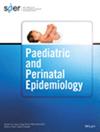在探索早期发展的研究中发现不良表现和自闭症谱系障碍
IF 2.7
3区 医学
Q2 OBSTETRICS & GYNECOLOGY
引用次数: 0
摘要
背景婴儿在分娩时的表现可能是发育差异的早期指标。非头颈部先露(先露不良)会使分娩复杂化,通常会导致剖腹产,而剖腹产与神经发育迟缓有关,包括自闭症谱系障碍(ASD)。然而,胎位不正可能是现有发育问题的早期征兆,也是剖腹产的上游因素。我们研究了分娩时胎儿先露不良与自闭症谱系障碍之间的关系,以及这种关系是否会因胎龄不同而有所差异。我们通过医疗记录、出生记录和产妇访谈来确定胎儿的表现。我们将胎位不正定义为分娩时非头位,然后进一步分为臀位和其他胎位不正。我们使用多变量逻辑回归法估算了产程不良与 ASD 之间的调整赔率(aOR)。结果我们纳入了 4047 名 SEED 参与者、1873 名 ASD 患儿和 2174 名对照者。分娩时,大多数婴儿呈头顶型(n = 3760,92.9%)。在对产妇年龄、贫困程度、高血压疾病和吸烟进行调整后,胎位不正与较高的 ASD 发生几率相关(aOR 1.31,95% 置信区间 [CI] 1.02,1.68)。臀位和其他类型的胎位不正的相关性相似(aOR 分别为 1.28,95% CI 0.97,1.70 和 aOR 1.40,95% CI 0.87,2.26),且与胎龄没有明显差异。对先天性先露不良儿童的神经发育进行早期监测,可以更早地发现患有 ASD 的儿童,并增加提供支持的机会,以优化发育结果。本文章由计算机程序翻译,如有差异,请以英文原文为准。
Malpresentation and autism spectrum disorder in the study to explore early development
BackgroundAn infant's presentation at delivery may be an early indicator of developmental differences. Non‐vertex presentation (malpresentation) complicates delivery and often leads to caesarean section, which has been associated with neurodevelopmental delays, including autism spectrum disorder (ASD). However, malpresentation could be an early sign of an existing developmental problem that is also an upstream factor from caesarean delivery. Little research has been done to investigate the association between malpresentation and ASD.ObjectivesWe examine the association between malpresentation at delivery and ASD and whether this association differs by gestational age.MethodsWe used data from the Study to Explore Early Development (SEED), a multi‐site, case–control study of children with ASD compared to population controls. The foetal presentation was determined using medical records, birth records and maternal interviews. We defined malpresentation as a non‐vertex presentation at delivery, then further categorised into breech and other malpresentation. We used multivariable logistic regression to estimate the adjusted odds ratio (aOR) for the association between malpresentation and ASD.ResultsWe included 4047 SEED participants, 1873 children with ASD and 2174 controls. At delivery, most infants presented vertex (n = 3760, 92.9%). Malpresentation was associated with higher odds of ASD (aOR 1.31, 95% confidence interval [CI] 1.02, 1.68) after adjustment for maternal age, poverty level, hypertensive disorder and smoking. The association was similar for breech and other types of malpresentation (aOR 1.28, 95% CI 0.97, 1.70 and aOR 1.40, 95% CI 0.87, 2.26, respectively) and did not differ markedly by gestational age.ConclusionsMalpresentation at delivery was modestly associated with ASD. Early monitoring of the neurodevelopment of children born with malpresentation could identify children with ASD sooner and enhance opportunities to provide support to optimise developmental outcomes.
求助全文
通过发布文献求助,成功后即可免费获取论文全文。
去求助
来源期刊
CiteScore
5.40
自引率
7.10%
发文量
84
审稿时长
1 months
期刊介绍:
Paediatric and Perinatal Epidemiology crosses the boundaries between the epidemiologist and the paediatrician, obstetrician or specialist in child health, ensuring that important paediatric and perinatal studies reach those clinicians for whom the results are especially relevant. In addition to original research articles, the Journal also includes commentaries, book reviews and annotations.

 求助内容:
求助内容: 应助结果提醒方式:
应助结果提醒方式:


